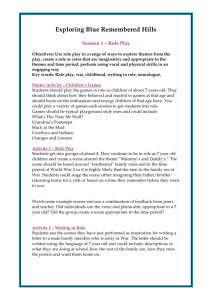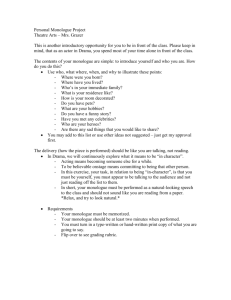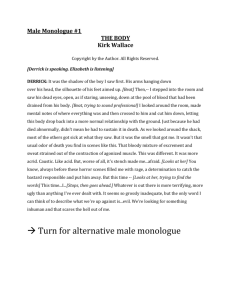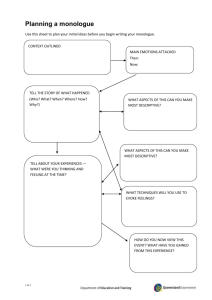Grade 6 Drama Collective Unit Plan: Identity & Collaboration
advertisement
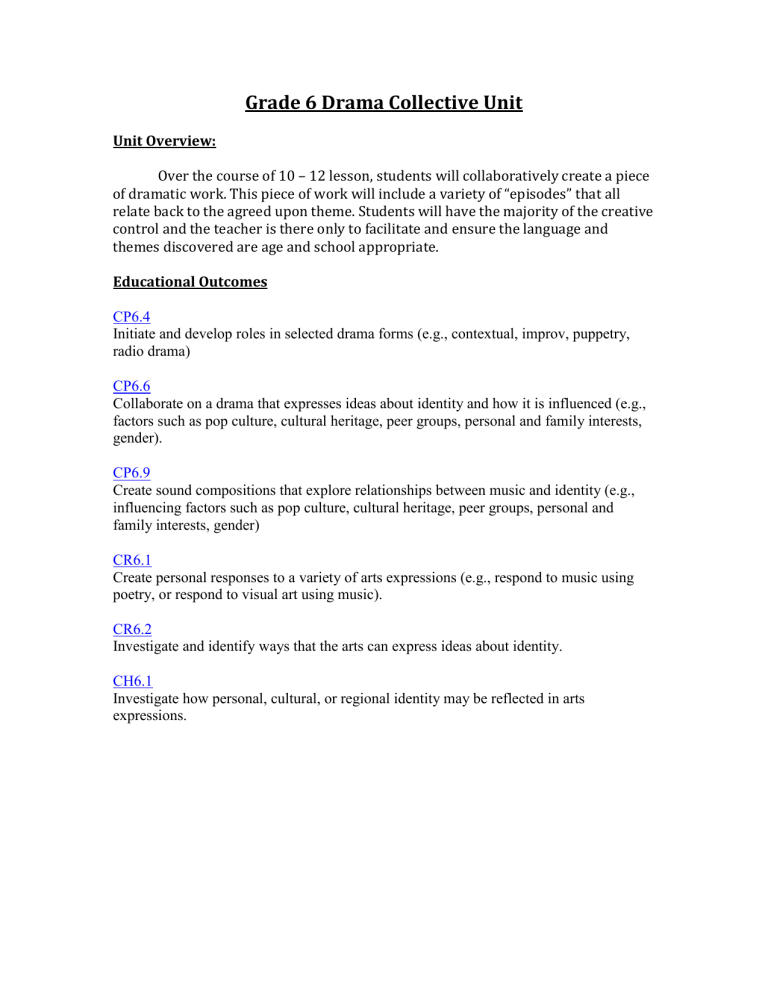
Grade 6 Drama Collective Unit Unit Overview: Over the course of 10 – 12 lesson, students will collaboratively create a piece of dramatic work. This piece of work will include a variety of “episodes” that all relate back to the agreed upon theme. Students will have the majority of the creative control and the teacher is there only to facilitate and ensure the language and themes discovered are age and school appropriate. Educational Outcomes CP6.4 Initiate and develop roles in selected drama forms (e.g., contextual, improv, puppetry, radio drama) CP6.6 Collaborate on a drama that expresses ideas about identity and how it is influenced (e.g., factors such as pop culture, cultural heritage, peer groups, personal and family interests, gender). CP6.9 Create sound compositions that explore relationships between music and identity (e.g., influencing factors such as pop culture, cultural heritage, peer groups, personal and family interests, gender) CR6.1 Create personal responses to a variety of arts expressions (e.g., respond to music using poetry, or respond to visual art using music). CR6.2 Investigate and identify ways that the arts can express ideas about identity. CH6.1 Investigate how personal, cultural, or regional identity may be reflected in arts expressions. Time Line Lesson 1 As a class, we will discuss the upcoming events we will be facing in drama. Teacher will explain what a “Drama Collective” is and what is expected of the students. Expectations: - Students will participate to the best of their ability Students will act respectfully towards each other and support each other as we try new things Students will contribute ideas and be accepting of ideas Students will take time at home to review/memorize or complete various works. Students will be good sports in the event their idea is not used Teacher will explain the various types of collectives (themed, location, character, event) As a class we will silent vote on the type we would like to do. Then, we will all think about ideas based on the type of collective we are doing – write them down on paper and do a vote for our idea – We will choose the top 3 ideas and students will choose one of those ideas and brain storm in groups the different ideas they have about that certain topic. Assessment – No formal assessment Lesson 2 - Start lesson with a warm up, both physical and mental. Each group will have 5 minutes to “pitch” their topic. After pitches are complete – we will have a silent vote. After we have decided our final topic for discover we will begin brainstorming PEOPLE PLACES SITUATIONS OBJECTS Under those headings, we will list all the things we can think of that relate to our topic. Assessment – no formal assessment Lesson 3 - Students will create character sketches today. They will choose a character (either from the brainstormed list, or a new idea) and draw a picture of what they think that character would look like. They will also fill in a character form that asks questions about their character. (Favorite food, interests, dislikes… etc) - Students will then write one paragraph in their journal finishing the following prompt: My character is similar/different to me because… Assessment: Character Sketch will be graded on a scale (see attached form) Character Information sheet will be graded (1 mark for answer, 2 marks for detailed answer) Lesson 4 - Based on their characters, teacher will place the students into groups for their first scene. Groups will be made based on the types of characters we have. - In their groups, students will share their character pages and information sheets with each other and create a similarity and differences chart on the characters. -The teacher will then lead the students in a character walk. This will be the first time students will have the opportunity to actually embody their characters and try them out! -Teacher will ensure that they get the chance to explore by themselves, but also with interactions with each other. Assessment: Student will complete a self-assessment for todays lesson Lesson 5 - Students will work in their groups to start brainstorming ideas for their first scene Where does the scene take place? Why are all of your characters there? What is happening in the scene? What is the conflict of the scene? How is the conflict solved? How does the scene relate to the overall topic? - Students will show their planning page to the teacher once they are completed. If done early students can start practicing their scenes and adding dialogue to it. Assessment: Students will receive 10 marks for completing their planning page. Lesson 6 - Students will use this class to finish planning their scenes and start practicing them in the mini gym. Students will work collaboratively to block their scenes and come up with their story line. - The teacher will work with each group multiple times throughout the lesson to help provide direction and focus, but each group is responsible for the content explored. - Each group must also come up with a title for their scene as well. Assessment: Students will complete a self-assessment form for this lesson. Lesson 7 - Students will receive the first 20 minutes to practice and remember their scenes. Students will then each share their scenes with the remainder of the class. As a class we will workshop the scenes and talk about the good points, as well as what we can improve on. We will fill out a chart on the board that looks something like this Group Clear Clear Clear Clear Relates Actors Setting Characters Problem Solution to Topic can all be heard Group 1 Group 2 - Each group is responsible for taking notes on what their scene did well and what it needs improving on. Assessment: No formal Assessment Lesson 8: - Students will create monologues during this class. We will begin with a discussion of what a monologue is. Students will then create a one page monologue that states their opinion of or feelings towards the topic (from the point of view of their character) - Once they have completed their monologue they may begin practicing reading that monologue out loud. Assessment: The student’s monologues will be graded based on a rubric (see form attached) Lesson 9: - Students will get the class period to work with a partner on their monologue. Time should be spent editing, and practicing saying it verbally. Teacher will make frequent visits to each group and hopefully hear everyone’s monologue at least once. Lesson 10: - Students will get the first 10 minutes to practice their monologue. Students will share their monologue out loud. As a class we will decide an order for all of our scenes/monologues. Perhaps not all will be chosen but every student will be involved and have a role. Lesson 11 – 13 - Over the next few lessons, students will have the opportunity to work in their groups to remember their scenes and practice. They will need to decide on costumes, props etc. We will also decide as a group how we would like to open the performance, and close the performance. Final Performance! Final Assessment: - Students will complete a group evaluation form that asks them to assess their group members as well as themselves. - Teacher will record the performance, so that it can be watched again. Teacher will grade the student’s individual performance based on a rubric. Students will know how they are being assessed prior to final performance.
